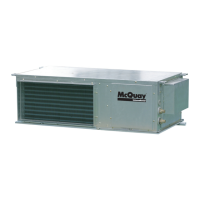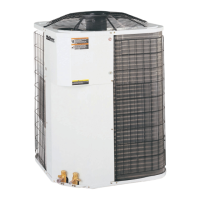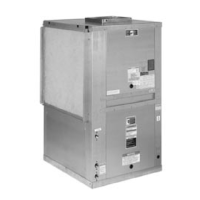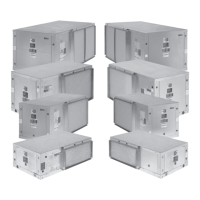IM 985-1 / Page 11 of 36
Cleaning & Flushing Water System
Prior to first operation of any unit, the water circulating
system must be cleaned and flushed of all construction dirt
and debris.
If the unit is provided with water shutoff valves, either elec-
tric or pressure operated, the supply and return run outs
must be connected together at each unit location. This will
prevent the introduction of dirt into the water circulating
system. Additionally, pressure operated valves only open
when the compressor is operating.
1. Priortorstoperationofanyunit,thewater
circulatingsystemmustbecleanedandushedofall
construction dirt and debris.
If the units are equipped with water shutoff valves,
either electric or pressure operated, the supply and
return run outs must be connected together at each
unit location. This will prevent the introduction of
dirt into the unit. See Figure 9.
Figure 9. Connections for ushing system piping
2. Fill the system at the city water makeup connection
withallairventsopen.Afterlling,closeallair
vents.
The
contractor should start main circulator with
the pressure reducing valve open. Check vents in
sequence to bleed off any trapped air, ensuring
circulation through all components of the system.
Power to the heat rejector unit should be off, and the
supplementary heat control set at 80°F (27°C).
While circulating water, the contractor should check
and repair any leaks in the unit and surrounding
piping. Drains at the lowest point(s) in the system
shouldbeopenedforinitialushandblow-down,
makingsurecitywaterllvalvesaresettomakeup
water at the same rate. Check the pressure gauge at
pump suction and manually adjust the makeup to
hold the same positive steady pressure both before
and after opening the drain valves. Flush should
continue for at least two hours or longer until the
drain water is clean and clear.
NOTICE
CAUTION
CAUTION
Units must be checked for water leaks upon initial water
system start-up. Water leaks may be a result of mishan-
dling or damage during shipping. Failure by the installing
contractor to check for leaks upon start-up of the water
system could result in property damage.
Return Runout
Supply Runout
Mains
Flexible Hose
Runouts Initially
Connected Together
3. Shut off supplemental heater and circulator pump
and open all drains and vents to completely drain
down the system. Short circuited supply and return
run outs should now be connected to the unit supply
and return connections. Do not use sealers at the
swivelareconnectionsofhoses.
4. Flush system with water for 2 hours or longer until
water is clean.
5. Rellthesystemwithcleanwater.Testthewater
using litmus paper for acidity, and treat as required
to leave the water slightly alkaline (pH 7.5 to 8.5).
Thespeciedpercentageofantifreezemayalsobe
added at this time. Use commercial grade antifreeze
designed for HVAC systems only. Do not use
automotive grade antifreeze (See Table 2 on page 10
for Antifreeze Correction Factors).
Oncethesystemhasbeenlledwithcleanwaterand
antifreeze (if used), precautions should be taken to
protect the system from dirty water conditions.
It is McQuay International’s policy not to make recom-
mendations on water treatment. It is the responsibility of
the user to check that the water supply to the units is free
of contaminants or corrosive agents, chemicals or miner-
als. The general contractor or owner should contact a
local water treatment company regarding water treatment.
A fouled closed loop water system will lead to premature
component failure.
Note: Contact a local water treatment company to
conrm water clarity prior to unit operation.
Dirty
water will result in system wide degradation
of performance and solids may clog system-wide
valves,strainers,owregulators,etc.Additionally,
the heat exchanger may become clogged which
reduces compressor service life or causes premature
failure.
6. Set the loop water controller heat add setpoint
to 70°F (21°C) and the heat rejection setpoint to
85°F (29°C). Supply power to all motors and start
thecirculatingpumps.Afterfullowhasbeen
established through all components including the
heat rejector (regardless of season) and the vented
air and loop temperatures have been stabilized, each
of the units will be ready for check, test and start-up,
air balancing, and water balancing.

